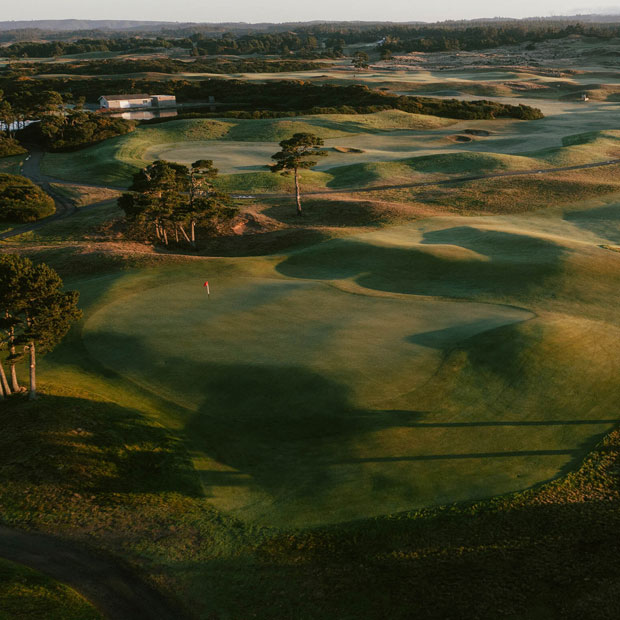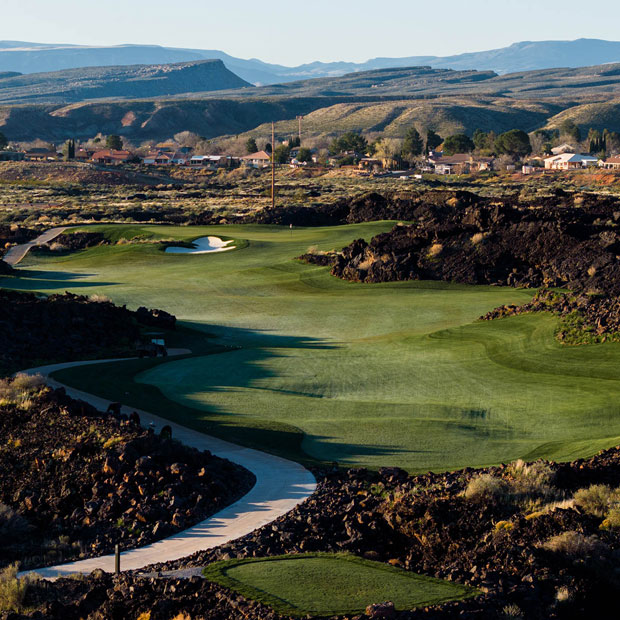Bandon Dunes
Bandon Dunes is still the Oregon resort’s most popular course, and for good reason: it provides an accessible introduction to the “Dream Golf” recipe

Bandon, Oregon, USA
David McLay Kidd (original design, 1999)
Public
$$$
Chocolate Drops: Underrated Holes at U.S. Women’s Amateur Host Bandon Dunes
Bandon Deep Dives: Bandon Dunes
The first golf course at the Bandon Dunes Golf Resort prompted two distinct sea changes in the golf industry. First, it demonstrated that the Field of Dreams principle—"if you build it, they will come"—applied to publicly accessible resorts, not just to private getaways like Sand Hills Golf Club. This revelation sent shockwaves through the golf industry, spawning a still-thriving genre of far-flung, sand-based resort golf. Second, the course itself—designed by a young David McLay Kidd, with input from developer Mike Keiser—set a new standard for the authenticity of American "links-style" golf architecture. The tumbling wildness of Bandon Dunes’ inland holes, combined with the grandeur of the ones on the cliffs above the Pacific Ocean, garnered ecstatic comparisons to Royal Dornoch and Ballybunion.
In retrospect, the course looks more like a bridge between eras than a fully realized example of modern neoclassical golf architecture. Its routing has some clunky passages, and its shaping lacks the sophistication and seamlessness of Coore & Crenshaw's and Tom Doak's later work in the same neighborhood. Yet Bandon Dunes remains the resort’s most popular course, and for good reason: it provides an accessible introduction to the “Dream Golf” recipe, mixing familiar and exotic flavors into an exciting dish.
Take Note...
A last-minute deal. The initial site for Bandon Dunes was somewhat cramped, resulting in some back-and-forth holes in Kidd’s early routings. Keiser knew that the course could be improved if he were to acquire the 400-acre parcel to the north, owned by an eccentric California lawyer named David Shuman. For years, Shuman refused to sell. After he went bankrupt in 1995, however, he became amenable to a $2.3-million offer from Keiser. The deal relieved some congestion in the routing of Kidd’s front nine, allowing the fourth green to be pushed out to the bluffs and the current fifth, sixth, seventh, and eighth holes to be created. The rest of Shuman’s property eventually became home to 16 of the 18 holes on Tom Doak’s Pacific Dunes course.
A twilight loop. Unlike any of the resort’s other courses, Bandon Dunes has conventional returning nines. This means guests can play the front nine in the evening—a convenient option for those arriving after a cross-country flight and a car ride to the Oregon coast.
Roughed up. The original bunkers at Bandon Dunes had clean shapes and grass faces. They looked a great deal like the bunkers at Gleneagles in Scotland, where Kidd’s father Jimmy worked as course manager. However, after Doak proved at Pacific Dunes that flashed, ragged-edged sand hazards could be functional on the windy property, the resort rebuilt Bandon Dunes’ bunkers in a more naturalized style.
{{content-block-course-profile-bandon-dunes-001}}
Favorite Hole
No. 10, par 4, 362 yards
The most famous holes at Bandon Dunes are the seaside ones, such as the thrilling fourth and 16th. The best-designed holes on the course, however, are mostly inland, draped over a rumpled dunescape. My favorite of these is the 10th, an unassuming but smartly conceived par 4.
The strategic geometry of this hole is similar to that of the iconic 10th at Riviera Country Club. There is a large hazard—in this case, a trio of deep bunkers gouged out of a dune ridge—blocking the direct line to the green. Carrying this obstacle dramatically shortens the hole. However, as on No. 10 at Riviera, the approach from the center of the fairway is difficult: from that angle, the green plays shallow and is completely hidden by a second dune ridge. The alternative route from the tee is well out to the left. From there, the green is mostly visible and more receptive to less-than-precise approaches.
This hole is one reason why Bandon Dunes immediately stood apart from other modern resort courses in the U.S. when it opened. David McLay Kidd’s design, in its best moments, is not only visually impressive but also strategically sound.
Favorite Hole
No. 10, par 4, 362 yards
The most famous holes at Bandon Dunes are the seaside ones, such as the thrilling fourth and 16th. The best-designed holes on the course, however, are mostly inland, draped over a rumpled dunescape. My favorite of these is the 10th, an unassuming but smartly conceived par 4.
The strategic geometry of this hole is similar to that of the iconic 10th at Riviera Country Club. There is a large hazard — in this case, a trio of deep bunkers gouged out of a dune ridge—blocking the direct line to the green. Carrying this obstacle dramatically shortens the hole. However, as on No. 10 at Riviera, the approach from the center of the fairway is difficult: from that angle, the green plays shallow and is completely hidden by a second dune ridge. The alternative route from the tee is well out to the left. From there, the green is mostly visible and more receptive to less-than-precise approaches.
This hole is one reason why Bandon Dunes immediately stood apart from other modern resort courses in the U.S. when it opened. David McLay Kidd’s design, in its best moments, is not only visually impressive but also strategically sound.

{{bandon-dunes-favorite-hole-gallery}}
Overall Thoughts
To appreciate how fresh and exciting Bandon Dunes felt in 1999, you have to imagine a world without Barnbougle Dunes, Streamsong, Cabot Cape Breton, Sand Valley, Cabot Highlands, Te Arai, or Seven Mile Beach. A world where, just a few years prior, the management firm KemperSports had advised developer Mike Keiser to hire a “name” golf architect and attempt to create the “Myrtle Beach of the Northwest.” A world where writers repeatedly compared Bandon Dunes to Pebble Beach and Whistling Straits because there were no other reference points for seaside (or lakeside) public golf of similar quality in the U.S.
Over the years, as competitors entered the marketplace, Bandon Dunes’ weaknesses came into sharper relief. Still, I think it’s important to remember the ways in which David McLay Kidd’s design pushed public golf architecture forward.
To a degree that unsettled many golfers at the time, Bandon Dunes embraced quirk. Its expansive, rippling greens were far more chaotic and naturalistic than anything Jack Nicklaus or Tom Fazio would have been comfortable building. Several holes featured punitive center-line bunkers—a hallmark of the British and Irish links but a rarity in modern American golf. In a few instances, such as on the approach to the 10th green, Kidd hid landing zones from the player’s view. Finally, and perhaps most importantly, he defied the conventional wisdom that fairways should provide flattish lies. Particularly on Nos. 7, 10, and 13, Kidd kept the hurly-burly undulations of the natural terrain intact, giving those holes an unforgettable sense of adventure.
{{bandon-dunes-content-block-gallery-01}}
But Bandon Dunes is not purely an exercise in eccentricity. In fact, it has many familiar and crowd-pleasing traits. The course contains the usual mixture of par 3s, 4s, and 5s; the ninth hole dutifully returns to the clubhouse; the routing loops around the site and visits the cliffs at regular intervals, following the well-known example of Pebble Beach; and the ocean-framed shots into the fourth, 12th, 15th, and 16th greens provide easy fodder for magazine photographers. These conventional elements allowed Keiser to feel confident that Bandon Dunes would have broad appeal. To this day, the course offers a smooth on-ramp to the Dream Golf style for golfers accustomed to stock-standard American fare.
{{bandon-dunes-content-block-gallery-02}}
It worked that way for me, at least. Bandon Dunes was the first course I played after arriving on the grounds, and I was stunned by it. I remember standing on the 17th tee, looking out at the Pacific Ocean, and thinking, “This has to be the best course I’ve ever set foot on.” But then I played Pacific Dunes, Bandon Trails, and Old Macdonald. It was immediately apparent to me that those courses were on another level architecturally—more consistent, polished, and mature.
While many holes at Bandon Dunes show Kidd’s talent and flair as an architect (see: the fifth, seventh, 10th, 13th, 14th, 16th, and 17th), several others pass without making a specific impression. Nos. 9 and 18, both par 5s, are especially disappointing, seeming to exist mainly to deliver players back to the clubhouse. The sixth hole is another miscue. Added late in the design process, this par 3 sits adjacent to the cliffs above the Pacific Ocean but feels oddly divorced from its setting, with its green artificially perched above the surrounding grade. The hole also creates an awkward gap in the routing: after putting out on the sixth green, players must retrace their steps in order to reach the seventh tee. I think Kidd should have left this piece of ocean frontage alone and instead carved a par 3 out of the gorgeous dunes behind today’s seventh green.
The quality of Bandon Dunes’ shaping is inconsistent as well. On some holes, Kidd’s team executed elegant tie-ins between manufactured and preexisting landforms. The eighth, 14th, and 17th greens are particularly well blended into their sites. In other cases, however, the artificial elements are more visible. On the third hole, for example, the drainage components—basins in the fairway, run-offs around the pushed-up green—are too regularly spaced and too different in shape and scale from the surrounding topography to seem natural. These instances of clumsy shaping weaken the course’s connection to the landscape.
The fact that Bandon Dunes feels less refined than the Keiser family’s later projects is not surprising. David McLay Kidd was a rookie architect, and Mike Keiser had not yet dialed in his development strategies. Whereas Pacific Dunes and Bandon Trails were molded by expert artisans who had trained for years with Tom Doak and Bill Coore, Bandon Dunes was built by a contractor called Servicescape, a lead shaper who had worked primarily for Rees Jones, and a crew of inexperienced locals.
Perhaps, then, we should celebrate that Bandon Dunes turned out as well as it did, and that it opened the door for even better courses to be created.
1 Egg
Bandon Dunes boasts an astonishing property—one that offers just as much potential for great golf inland as it does seaside. The best holes on the course are among the most beautiful and memorable anywhere. Ultimately, though, Bandon Dunes is less skillfully designed and built than more recent Dream Golf productions.
Course Tour

{{bandon-dunes-content-block-course-tour}}
Leave a comment or start a discussion
Get full access to exclusive benefits from Fried Egg Golf
- Member-only content
- Community discussions forums
- Member-only experiences and early access to events



















Leave a comment or start a discussion
Lorem ipsum dolor sit amet, consectetur adipiscing elit. Suspendisse varius enim in eros elementum tristique. Duis cursus, mi quis viverra ornare, eros dolor interdum nulla, ut commodo diam libero vitae erat. Aenean faucibus nibh et justo cursus id rutrum lorem imperdiet. Nunc ut sem vitae risus tristique posuere. uis cursus, mi quis viverra ornare, eros dolor interdum nulla, ut commodo diam libero vitae erat. Aenean faucibus nibh et justo cursus id rutrum lorem imperdiet. Nunc ut sem vitae risus tristique posuere.